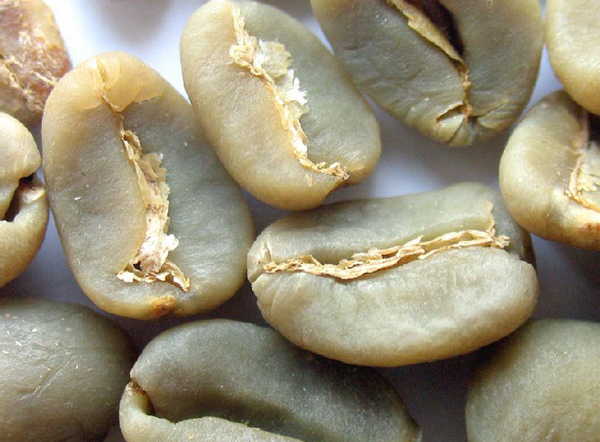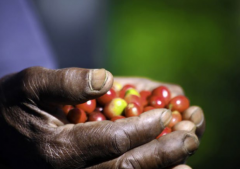Water content of coffee beans processed and stored fresh coffee beans fresh coffee
Fine coffee has a rich and wonderful taste. Even if the coffee made with fine coffee beans is not all fine coffee, it depends on whether it gives full play to the characteristics of coffee beans, whether it has a good taste feeling, if not, it cannot be called fine coffee. The term boutique coffee was first coined by Ms. Knudsen in Coffee and Tea magazine in the United States, when Ms. Knudsen served as B.C. Ireland's coffee buyer in San Francisco, she is very dissatisfied with the industry's neglect of green coffee bean quality, and even some large roasters mix a large number of robersta beans into the mixed beans, so she proposed the concept of fine coffee to advocate the industry to improve quality. The term is used to describe coffee beans that have distinctive flavor characteristics and are grown in special environments. Its use at international coffee conferences spread quickly.
Chapter 3: Processing and Storage of Raw Beans
The processing technology and method of coffee beans directly affect the quality of a cup of coffee, and determine its proprietary roasting method. Once the green coffee beans are processed, a roaster must exercise effective control over the packaging and storage conditions of the beans to avoid degradation before roasting.
Here are the main methods of raw bean processing:
Washing, solarization and honey treatment are the three main green bean treatments of modern fine coffee.
Wet planing/washing steps:
Coffee berry peel removed
Removal of pectin by fermentation or mechanical principles
Rinse pectin softened by fermentation with plenty of water
Coffee beans with sheepskin are mechanically dried (1 - 2 days) or sun-dried (3 - 16 days)
Dry planing/solarization:
There are two methods of treatment: one is not picking, but let the coffee berries be dried on the tree before picking and peeling; the other is picking mature coffee berries, drying and peeling.
Honey treatment:
This treatment method refers to the ripe coffee berries picked directly after the peel, retain the internal pectin for drying or drying. This process produces sweeter and cleaner coffee than traditional green bean processing.
The washing treatment method has hygienic supply and demand, high acidity of coffee taste, and can achieve durability and consistency of quality compared with other treatment methods. Although the price of raw beans treated with sun and honey is speculated and unreliable on the market at present, the cost of washing raw beans is much higher than that of the latter two. Water washing produces a higher density (hardness) of green coffee beans, which requires more experience and skill on the part of the roaster. Solarization requires several weeks for the green beans to dry out in natural conditions (to reach the standard moisture ratio of the green beans), resulting in coffee with lower acidity, higher body and more ground flavor than washed coffee. Dry regions often use this method to treat green beans because it saves water. During roasting, green coffee beans made by honey treatment are more likely to absorb heat than sun or washed beans, so roasters should lower the temperature in the oven and not use too much heat when roasting green beans.
Storage of green coffee beans
In recent years, processed green coffee beans have been packed in burlap bags (jute woven) and loaded into containers that can take months to ship to the consumer country. Baking plants and importers send people to the origin for "pre-loading sampling," such as frequent cup tests. The goal is to avoid the possibility of returning coffee beans once they have deteriorated due to exposure to harsh environmental conditions during transportation.
Over the past decade, small, boutique coffee roasters have revolutionized the transportation and storage of green beans. Many coffee roasters, even some small in-house roasters, have adopted a "direct supply" approach with coffee plantation owners to share cup testing and green bean grade information, which is conducive to reducing transportation time, improving green bean preservation packaging design, and controlling green bean quality. The more advanced the packaging method of green beans, the higher the cost, thus making the price of specialty coffee higher.
Here is a common way to package raw beans:
burlap sack (jute)
Burlap sack is the most common and the lowest cost way of packaging raw beans for transportation. Jute is a renewable resource, the cost of making bags is very low, and there are no technical requirements for its use. Burlap bags are not resistant to moisture or spoilage, and they are vulnerable to bumps and damage during transportation and storage.
Vacuum plastic bag
Vacuum packaging plastic bags are the best on the market at present, it can prevent raw beans from moisture, deterioration, oxidation, it can make raw beans isolated from the air and can not breathe, that is to say, can extend the life of raw beans. Before vacuumizing, the moisture content and moisture activity of raw beans must be measured to avoid spoilage and long hair after vacuumizing. Vacuum packaging costs about 15 to 25 cents per pound (about $1 for 500 grams of raw beans) and requires vacuum equipment and technical training for personnel.
(The left side of the above picture is vacuum plastic packaging, and the right side is grain woven bag packaging. These two packaging methods are effective in preventing coffee beans from getting wet or deteriorating)
GrainPro (Grain Woven Bag)
Grain woven bags can protect coffee from moisture and spoilage, and they are better and cheaper than vacuum packaging. Woven bags for grain last longer than burlap bags for coffee, but only half the shelf life of vacuum plastic packaging. Grain bags cost about 5 to 10 cents per pound (about 50 cents for 500 grams of raw beans) and are the best choice for specialty coffee roasters. Since even before vacuum packaging to measure the moisture in beans to avoid its vacuum after the growth of other microorganisms, food packaging should pay more attention to this point.
stored frozen
That is to say, the vacuum-packed raw beans can be stored in an environment below zero for decades. Some roasters store unique batches of single-origin beans for decades to become "vintage" coffee beans, but demand for this vintage coffee is not high at present. (Huaxia Lingling went to Amber Coffee in Tokyo, Japan last December and ordered a cup of Mexican aged beans picked in 1962. The aroma is full, the flavor is still the same, the mellow is rich, not bitter, not sour, sweet and delicious. Presumably, Grandpa Guan Guan used this method to store raw beans.) Frozen storage costs are very high. To be honest, it is more extravagant and wasteful. This method of storage is necessary in hot and humid climates, as raw beans stored in extremely hot areas deteriorate within a few days.
Regardless of the storage method chosen, it is important for a baker to know and adjust the environment in which he stores his green beans to be consistent throughout the year. Especially in hot and humid environments, the farther away from the ground the better, but the higher the ground, the higher the temperature, if the raw beans are stored too close to the baking machine, the heat emitted by the baking machine will damage the quality of the raw beans.

Water activity and moisture content
Water activity is a measure of the toughness between water and other substances in green coffee beans. Water activity tells you how efficiently water evaporates and absorbs from green coffee beans, that is, how the green beans interact with the storage site in terms of moisture, and how long it takes for coffee beans to deteriorate under certain conditions.
Water activity is distinguished from moisture content and is calculated as a percentage of the weight of moisture in the raw beans to the total weight. The two values are proportional, but as the water content exceeds 12%, the two values begin to be out of proportion. Both data affect the quality of a cup of coffee, the aging rate of green beans, and the risk of microbial growth in storage.
The author has not studied professionally how the raw bean water activity data affects a cup of coffee, but a good friend of the author, who is also an importer and purchaser of raw beans, understands the raw bean water activity as follows:
Normal water activity of raw beans should be maintained at 0.53~0.59
For ideal raw beans, the moisture content should be between 10.5% and 11.5%.
The ideal storage environment room temperature should be 20~22 degrees Celsius
The humidity of the ideal storage environment should be between 45% and 50%.
These perfect values add up to a good deal of durability for the quality of a cup of coffee. For some frozen beans, it takes a few days to bake them at room temperature without opening them.
(The graph above shows the relationship between water activity and water content of raw beans. As can be seen, after the water content exceeds 12%, the blue dots representing water activity begin to spread. It means that the water content of raw beans is too high, and the water activity of raw beans cannot be captured.)
seasonal factors
In recent years, many coffee roasters have only looked at "seasonal beans." As with other factors in the coffee field, there is no consensus concept on seasonal factors for green coffee beans. Some people think that "in season beans" are the most recently picked and processed beans; others think that the definition of "in season beans" is determined based on the number of random green beans at a certain time after picking.
The reason we pay attention to seasonal factors is because we pay attention to the quality of a cup of coffee. A cup of your vibrant coffee, with moderate acidity and no traces of stale beans (paper, plastic, dryness, lack of organic ingredients, etc.) is much more important than whether the beans are in season! There was really no need to make things so complicated!
Glossary of this chapter
Degradation
Mucilage pectin
Fermentation
Arid drought, water shortage
Burlap Sacks
Jute
Vacuum-sealed vacuum packaging
GranPro a patent, and our domestic woven bag is very similar, mainly used for packaging grain and grain
Moisture
Odors rancid
Oxygen Oxygen
Mold Long Hair
Microorganism
Water Activity (a^w) Water activity, the water pressure value inside the bean divided by the atmospheric pressure value of the storage environment. Ideally, the water activity index of the bean is 0.53~0.59.
Humidity
Seasonality Seasonal
Important Notice :
前街咖啡 FrontStreet Coffee has moved to new addredd:
FrontStreet Coffee Address: 315,Donghua East Road,GuangZhou
Tel:020 38364473
- Prev

The main points of correct identification of espresso common mistakes in the extraction of excessive Espresso espresso
[introduction] Espresso is an Italian word that means on the spur of the moment and for you. Espresso was born in 1946, and Gaggia further improved the piston pressure system by using spring pressure instead of manual pressing, allowing the brewed coffee to float with a layer of golden coffee oil Crema Cleima, which is C.
- Next

Physical changes of raw beans during heat absorption of roasted coffee beans wholesale raw bean merchants
Physical changes in roasting of raw beans change the color of coffee beans, evaporate moisture, increase their volume, and make coffee beans become brittle. Almost all people in the coffee industry regard color as the standard to measure the roasting degree of coffee, even if they are named for different roasting degrees, but there is no consensus on the roasting degree symmetrical by each name in the coffee industry. The first stage of roasting coffee beans is "roasting."
Related
- Beginners will see the "Coffee pull flower" guide!
- What is the difference between ice blog purified milk and ordinary milk coffee?
- Why is the Philippines the largest producer of crops in Liberia?
- For coffee extraction, should the fine powder be retained?
- How does extracted espresso fill pressed powder? How much strength does it take to press the powder?
- How to make jasmine cold extract coffee? Is the jasmine + latte good?
- Will this little toy really make the coffee taste better? How does Lily Drip affect coffee extraction?
- Will the action of slapping the filter cup also affect coffee extraction?
- What's the difference between powder-to-water ratio and powder-to-liquid ratio?
- What is the Ethiopian local species? What does it have to do with Heirloom native species?

